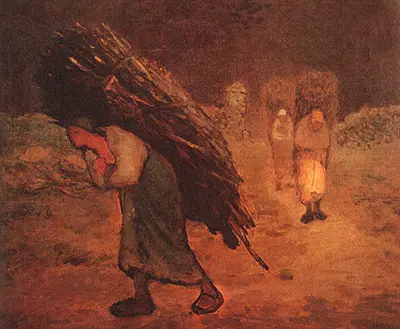 Buy Art Prints Now
Buy Art Prints Nowfrom Amazon
* As an Amazon Associate, and partner with Google Adsense and Ezoic, I earn from qualifying purchases.
As with so many of Jean Francois Millet's works, Winter, the F*ggot Gatherers both captures a typically rural scene and simultaneously invites thought and comment on the subject matter.
A word first on the title: while the word has largely fallen out of use in this context, the title contains no homophobic slur, the word 'f*ggot' in this case referring to small branches, such as those used as kindling or to encourage a faltering fire back to full heat and power.
This work, one of several on similar themes, is unfinished and was perhaps intended as one of a series of works, one or more from each of the seasons, or detailing several winter scenes. The unfinished quality of the painting lends it something of an air of a Gaugin, with the women merely suggested and not detailed as was customary with Millet.
However, this works well: the women are heavily burdened with their loads, they are returning after dark, which means that they were either busy with other tasks during daylight or that it has taken them a long time to find sufficient wood to last for as long as it needs to last.
Without any hint of motion, Millet manages to convey the great weight that the women bear, and the viewer cannot help but feel an answering sympathetic pang in feet and ankles, as they seem to hear the painful shuffling gait, and feel the great weight of the wood, perhaps made even heavier by the gathering damp of a chilly and overcast winter evening.
Three women are visible in the painting: one in the foreground could be said to be the main focus of the work while the two smaller figures offer a curiously symmetrical doubling effect, showing perhaps the endless drudgery of their days, wearing them down and diminishing them, despite their herculean efforts to keep body, soul and family together.
Millet had, at one point, different intentions for this work, it is clear – this can be seen in a still partially visible fourth female figure to the right of the canvas which he then painted over, either because his original design proved to be too ambitious, because the image became too 'busy' (the rule of threes is an important one in artworks to prevent just such crowding), or because the muse distracted Millet before abandoning him (for this work at least) entirely.
This painting can be seen in the National Museum of Wales in the Davies Sisters' Collection (named for their generous bequests to the museum.) It is in oil on canvas and measures 82cm by 100cm.




